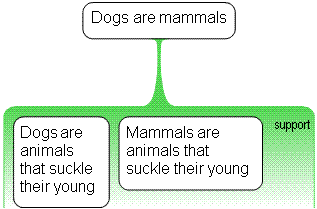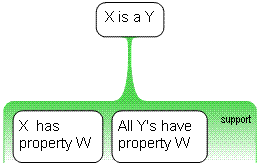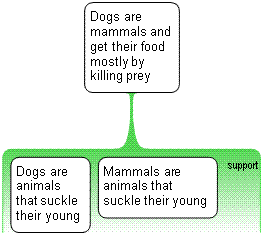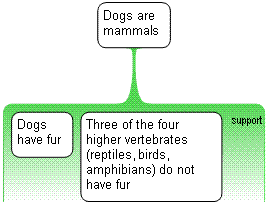The Science Of Scientific Writing Set 9 Set 9-Analysis maps • Second page • Example • Exercise 1 • Exercise 2 • Exercise 3 • Exercise 4 • Exercise 5 • Refinement Revisited • Rabbit Rule • Holding Hands Rule • Exercise 6 • Inference objections • Exercise 7 • Exercise 8 • Final.
OVERVIEW: The way to well-written science
PART I: Paragraphs and Sentences
SET A: Paragraphs: The Maps Behind Them
SET B: Paragraphs: Using Maps to Meet Readers' Expectations
SET C: Paragraph Coherence and Cohesion
SET D: Sentences
SET E: Scientific Sections (including Methods)
SET F: Scientific Sections: The Discussion
SET G : Scientific Sections: The Introduction
SET H : The Paper as a Whole
The Rabbit Rule
Look again at the long and shorthand versions of the Dog argument from the last page:


Putting the argument in the shorthand form makes it easy to see that the original argument abides by our second important rule of argument construction, The Rabbit Rule. This rule says that any significant term or concept which appears in the top claim must also appear in one of the premises that sit directly below it. Therefore (keeping in mind the Binary Rule as well) our upper claim could contain either (X and Y), (X and W) or (W and Y) but it could not introduce any new terms, let's call them P or Q.
Why is it called
the Rabbit Rule? The idea behind the rule is that you can't pull rabbits
out of hats just by magic.  If
a rabbit appears above the hat, it must have been put in there previously. In
argument mapping terms, nothing can magically appear in an upper level claim;
it must have been put in the premises below it first. The classic argument below
conforms to the requirements of the Rabbit Rule.
If
a rabbit appears above the hat, it must have been put in there previously. In
argument mapping terms, nothing can magically appear in an upper level claim;
it must have been put in the premises below it first. The classic argument below
conforms to the requirements of the Rabbit Rule.

The following argument does not, because the main claim has an important "term" (dogs' source of food) which is not mentioned in the premises below i:.

The Rabbit Rule is most useful for assessing an already composed argument map. When we are creating a map in the first place, it is more important to apply what is, when considered together with the Binary Rule, nearly a corollary of the Rabbit Rule - Rabbit In Reverse
Every lower premise must draw one of its two terms from the claim above it
We can see this is the case with the Socrates argument from above:

But consider this faulty argument:

Neither of the two main terms in the Assumption ( "Three of the four higher veretebrates.." and "fur") are found in the upper claim. We can see, with a bit of extra information, and a bit of effort, where the argument is coming from: A dog is a higher vertebrate, therefore it must either be a {mammal, reptile, bird or amphibian}. We can rule out it being a {reptile, bird or amphibian} because it has fur. Therefore it must be a mammal.
But of course, when arguing, we want our aguments to be as self-contained and effortless as they can be!
Content of this page drawn in whole or part from the Austhink Rationale Exercises with permission from Austhink.